| 
|
 he
narrowness of the St. Lawrence River in the Eastern
part of the province facilitated the crossing of troops, both
American and British. Small towns on each side of the river were
raided for supplies and to destroy enemy depots. he
narrowness of the St. Lawrence River in the Eastern
part of the province facilitated the crossing of troops, both
American and British. Small towns on each side of the river were
raided for supplies and to destroy enemy depots.
The garrison at Ogdensburg
on the American side had been strengthened early in the War as
part of the effort to gain control over the St. Lawrence, the
natural line of communication between the British provinces.
The illustration to the right shows Ogdensburg as it appeared
in 1830. |
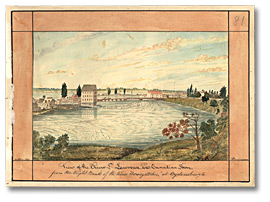
Click
to see a larger image (209K)
St. Lawrence River, at Ogdensburgh, 1830
Thomas Burrowes
Thomas Burrowes fonds
Watercolour
Reference Code: C 1-0-0-0-81
Archives of Ontario, I0002200
|
|
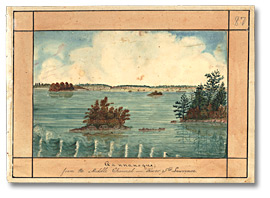
Click to see a larger image
(192K)
Gananoque from the St. Lawrence River, 1830
Thomas Burrowes
Thomas Burrowes fonds
Watercolour
Reference Code: C 1-0-0-0-87
Archives of Ontario, I0002206
|
In 1812
Gananoque
was a small, unfortified hamlet. It was the target of the first
American raid on September 21st, 1812. They
seized goods and burnt down the only military depot there, built
by
Joel
Stone during the previous summer
|
"This certify
(sic), that in the month of July 1812 I called on Col.
Stone for a store to deposit therein the provisions for
the troops at the post at Gananoque. He informed me that
he had not any proper and secure building, that we would
forthwith build a store for that purpose, which he did
do with dispatch. [This certify] that the King's provisions
etc. was therein deposited and the same was burnt by the
Enemy."
Extract
from an original Certificate by William Ross, D.A.G.G.
July 1814
Joel Stone family fonds
Reference Code: F 536, box MU 2892
Archives of Ontario
|
|
|
|
Civilians on both sides of the border preferred it
when the military left things alone. A raid by one side was sure
to lead to a response in kind.
|
"Upon my return
to [Utica] I found David Smith, who informed me the Saturday
after we left St. Lawrence, Foresyth made an expedition
to Brockville, by the way of Morris Town. Surprised it brought
off Mr. C. John, Capt. Stewart, [Corly], Capt. Sherwood,
David [Hubbel], and 40 or 50 others, took them to Ogdensburg,
paroled them & let them return – no lives lost.
Great expedition Forsyth suffered no soldier to enter a
house, so far so good. The folly, and mischief this may
produce, can only be anticipated. I hope for the best. I
am anxious to return before other folly is commenced …"
Extract
from an original letter from Nathan Ford (Ogdensburg)
to his brother David Ford, February 13, 1813
Ford family fonds
Reference Code: F483, box MU 1054
Archives of Ontario
|
|
|
|
Nathan Ford comments on a British raid on
Ogdensburg on February 22, 1813.
|
"I have not time
to tell you the history of Ogdensburg. I shall write you
the particulars. At present I can only tell you Ogdensburg
has been taken, & plundered all the public stores, cannon
& many families have been stripped to the last shirt.
The garrison is burnt and also the barracks & also the
schooner together with my still house. You are all safe
in Morris Town, they have been over they destroyed nothing.
I am happy to hear of your safe arrival. I shall write you
particularly tomorrow, we are all in confusion. I was in
[Utica] when the thing happened."
Extract
from an original letter from Nathan Ford (Ogdensburg)
to his brother David Ford,
February 27, 1813
Ford family fonds
Reference Code: F483, box MU 1054
Archives of Ontario |
|
[ Return to top
of page ]
|
|
| 
|
 he
most concerted effort by the United States to cut the St. Lawrence
supply line came in the fall of 1813. Concurrent invasions were
launched against Montreal via the St. Lawrence and overland into
Lower Canada from the south. American troops on their way down
from Sackets
Harbour, were pursued by British forces under the
command of Lieutenant-Colonel Morrison. A battle was fought on
November 11th when Major
General Wilkinson ordered his army to advance from
the Long Sault. he
most concerted effort by the United States to cut the St. Lawrence
supply line came in the fall of 1813. Concurrent invasions were
launched against Montreal via the St. Lawrence and overland into
Lower Canada from the south. American troops on their way down
from Sackets
Harbour, were pursued by British forces under the
command of Lieutenant-Colonel Morrison. A battle was fought on
November 11th when Major
General Wilkinson ordered his army to advance from
the Long Sault.
|
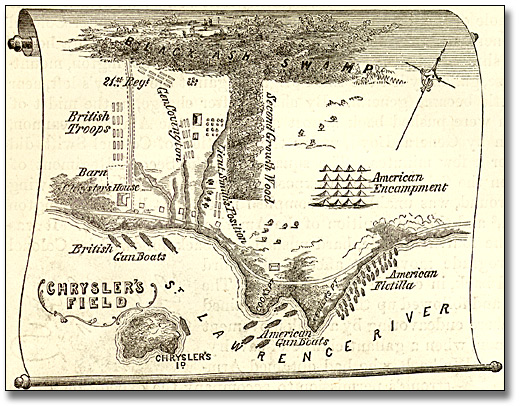
Click
to see a larger image (215K)
Map of the Chrysler's Field, 1869
Benson J. Lossing,
The Pictorial Field-Book of the War of 1812
An illustration
Reference Code: 971 .034 LOS, page 654
Archives of Ontario
|
|
"Gen[era]l Boyd
with 2500 men was ordered to disperse the pursuing army
which Gen[era]l Wilkinson estimated at 900 men. Wilkinson
with the raiders prepared to decend (sic) the Long Sault.
Gen[era]l Boyd found the British drawn up in order of battle
& the engagement lasted with obstinancy (sic) upon both
sides for three hours & an half. When our troops gave
way and retreated, our loss is stated by the officers to
be 500 killed, wounded & missing."
Extract
from an original letter from Nathan Ford (Ogdensburg)
to his brother David Ford, November 13, 1813
Ford family fonds
Reference Code: F483, box MU 1054
Archives of Ontario
|
|
"My dear father,
… I suppose you have had a full account of Col. Harveys
gallant affair of the 11 at Chrysler. I was on the field
of battle the next morning & it was covered with American
killed & wounded. We had buried some & about 80
lay dead, some scalped some horses were intermingled among
them. We had 11 killed on the field and 135 wounded some
of them whom died. Poor Capt. Naime was killed at the close
of the battle almost the last shot fired. It was fought
at Chryslers house on a burnt piece of ground half a mile
square. Our army were drawn up in a solitary line of 1,000
men from the woods to the river. The enemy is send out of
the woods in two large columns of 2,000 each besides 300
horses…" |
|
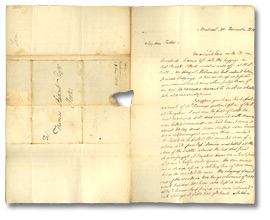
Click
to see a larger image (152K)
Letter from Thomas G. Ridout (Montreal) to
his father Thomas Ridout, November 20, 1813
Thomas Ridout family fonds
Extract from an original letter
Reference Code: F 43, box MU 2390
Archives of Ontario
|
|
|
|
The Americans continued their advance after the defeat
at Chrysler's,
but withdrew across the St. Lawrence and into winters quarters after
word was received that the joint operation against Montreal under
General Wade Hampton had turned back after the defeat at Châteauguay
in Lower Canada.
|
[ Return to top
of page ]
|
|
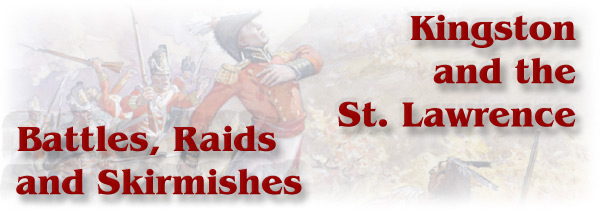





 he
narrowness of the St. Lawrence River in the Eastern
part of the province facilitated the crossing of troops, both
American and British. Small towns on each side of the river were
raided for supplies and to destroy enemy depots.
he
narrowness of the St. Lawrence River in the Eastern
part of the province facilitated the crossing of troops, both
American and British. Small towns on each side of the river were
raided for supplies and to destroy enemy depots.
